Comprehensive Marketing Plan: Amazon's Business Analysis Report
VerifiedAdded on 2023/06/07
|9
|2134
|272
Report
AI Summary
This report provides a comprehensive marketing plan analysis for Amazon, a leading e-commerce company. It begins with a situational analysis, examining macro (PESTEL) and micro environmental factors influencing Amazon's business. The report then conducts a competitor analysis, comparing Amazon to Alibaba, focusing on revenue, customer base, market share, and innovation. Finally, it presents a SWOT analysis, outlining Amazon's strengths, weaknesses, opportunities, and threats in the dynamic online retail landscape. This document is available on Desklib, a platform offering a wide range of study resources, including past papers and solved assignments, for students.

Running Head: PRINCIPLES OF MARKETING 0
PRINCIPLES OF MARKETING
PRINCIPLES OF MARKETING
Paraphrase This Document
Need a fresh take? Get an instant paraphrase of this document with our AI Paraphraser
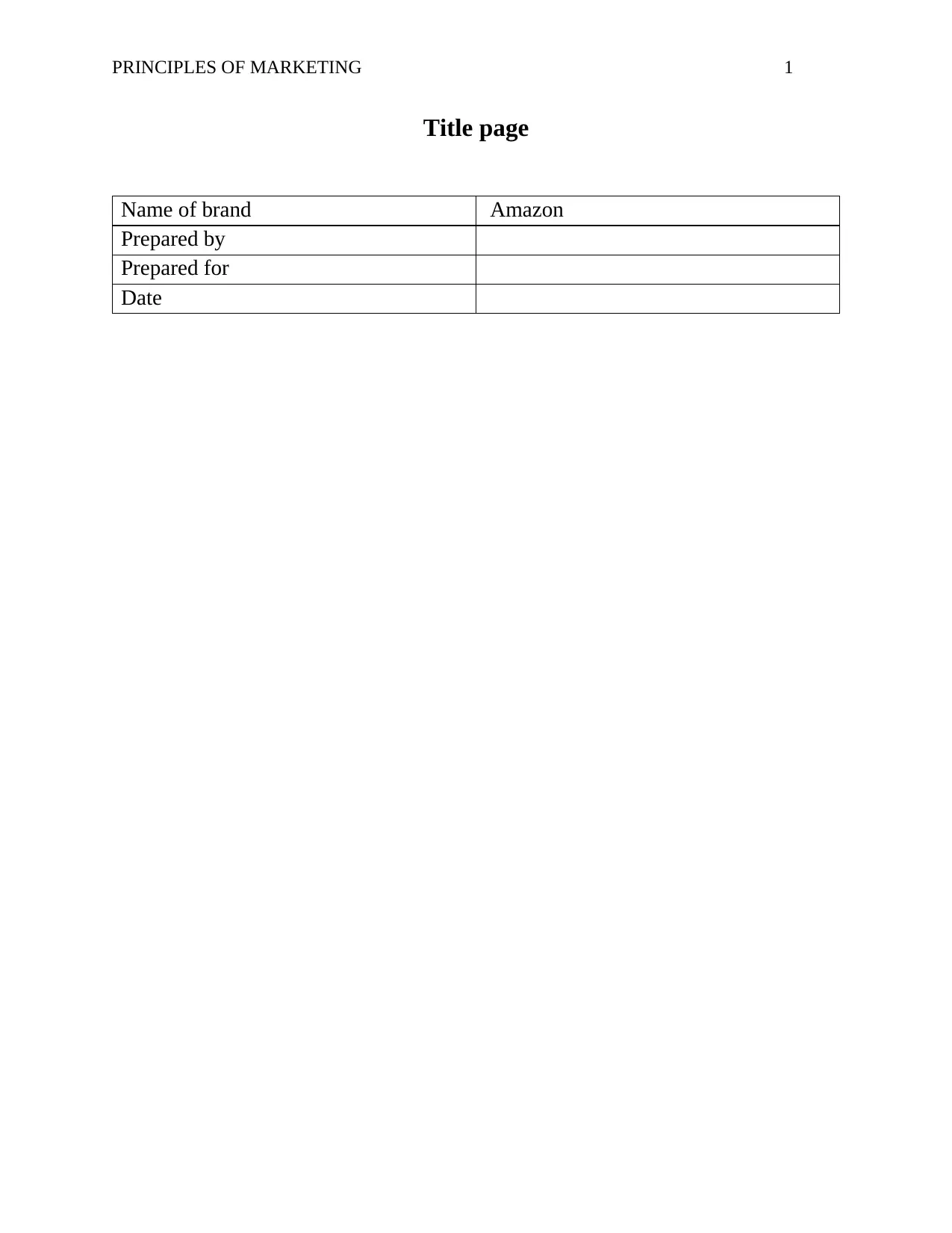
PRINCIPLES OF MARKETING 1
Title page
Name of brand Amazon
Prepared by
Prepared for
Date
Title page
Name of brand Amazon
Prepared by
Prepared for
Date
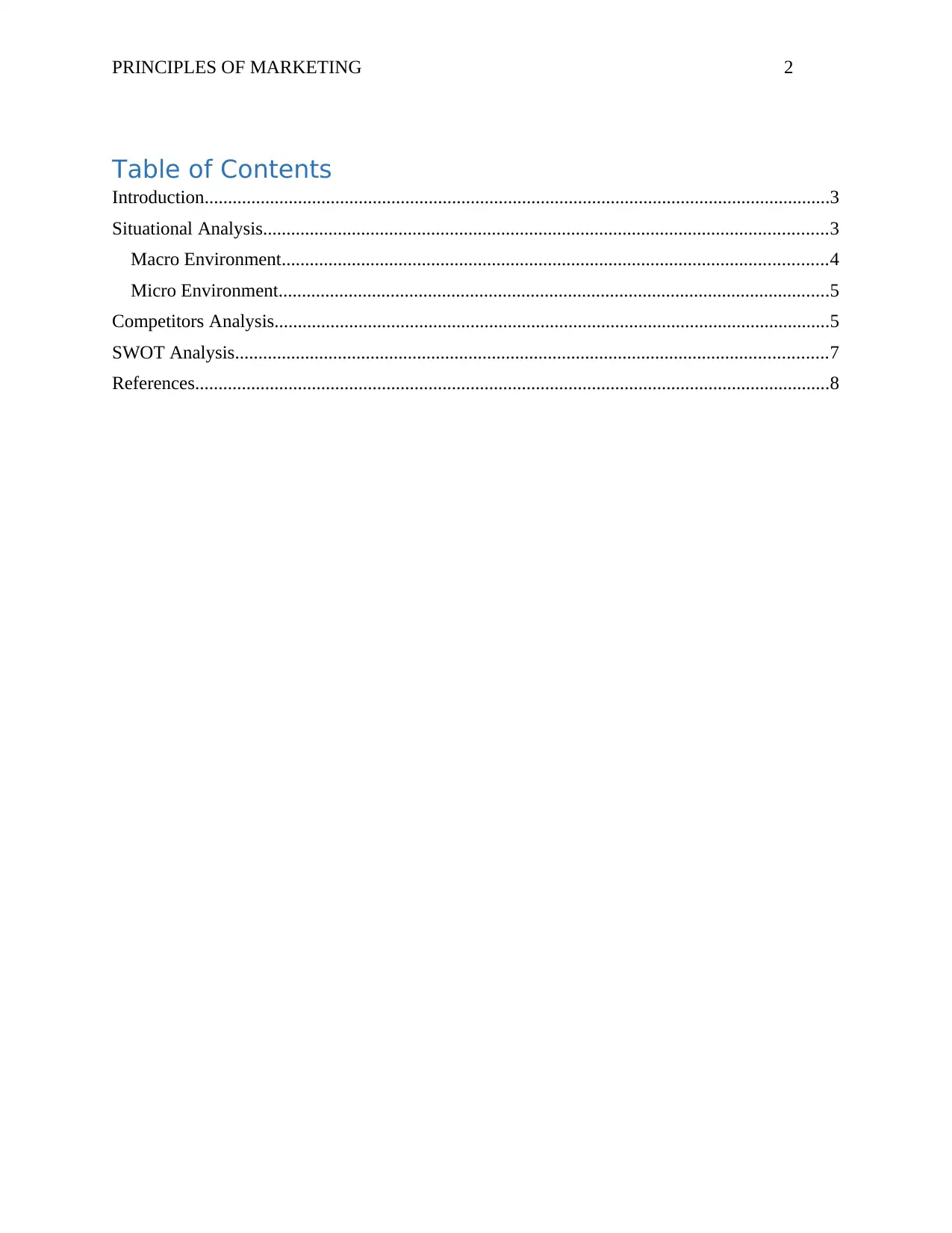
PRINCIPLES OF MARKETING 2
Table of Contents
Introduction......................................................................................................................................3
Situational Analysis.........................................................................................................................3
Macro Environment.....................................................................................................................4
Micro Environment......................................................................................................................5
Competitors Analysis.......................................................................................................................5
SWOT Analysis...............................................................................................................................7
References........................................................................................................................................8
Table of Contents
Introduction......................................................................................................................................3
Situational Analysis.........................................................................................................................3
Macro Environment.....................................................................................................................4
Micro Environment......................................................................................................................5
Competitors Analysis.......................................................................................................................5
SWOT Analysis...............................................................................................................................7
References........................................................................................................................................8
⊘ This is a preview!⊘
Do you want full access?
Subscribe today to unlock all pages.

Trusted by 1+ million students worldwide

PRINCIPLES OF MARKETING 3
Introduction
Amazon is one of the leading e-commerce company based in the United States. In the
early stage of Amazon, the major work was related to the online bookstore but Jeff Bezos, the
founder of Amazon, perceive Amazon to be the top retail website in the country and thus the
diversification was made in the company by selling of the DVDs, CDs, video games, electronics,
furniture and jewellery (Schneider, 2018). The company is also known for its innovation in the
technology due to the integration of many software developers, test engineers and user-interface
experts.
This is a report of the marketing plan of Amazon that outlines the blueprint of the
marketing efforts made by the business. According to the specific marketing objective, the
business activities are being defined so as to achieve the goal within the set time frame.
In the first section of the report, Amazon situational analysis needs to be done which
consists of the Macro and Microenvironment factors affecting the business. For this purpose,
PESTEL analysis is important as it gives an overall view of the business activities in the
industry.
In the next section, competitor analysis will be made between the Amazon and its one of
the competitor. In the last section, a SWOT matrix of the Amazon will be created which focuses
on the strength, weakness, opportunities and threats (in the external environment) facing b the
company.
Situational Analysis
This includes the analysis of the macro and micro factors of the business environment-
affecting amazon in its management decision making. For doing macro analysis, the approach is
being used as PESTEL (Wegener, 2011).
Introduction
Amazon is one of the leading e-commerce company based in the United States. In the
early stage of Amazon, the major work was related to the online bookstore but Jeff Bezos, the
founder of Amazon, perceive Amazon to be the top retail website in the country and thus the
diversification was made in the company by selling of the DVDs, CDs, video games, electronics,
furniture and jewellery (Schneider, 2018). The company is also known for its innovation in the
technology due to the integration of many software developers, test engineers and user-interface
experts.
This is a report of the marketing plan of Amazon that outlines the blueprint of the
marketing efforts made by the business. According to the specific marketing objective, the
business activities are being defined so as to achieve the goal within the set time frame.
In the first section of the report, Amazon situational analysis needs to be done which
consists of the Macro and Microenvironment factors affecting the business. For this purpose,
PESTEL analysis is important as it gives an overall view of the business activities in the
industry.
In the next section, competitor analysis will be made between the Amazon and its one of
the competitor. In the last section, a SWOT matrix of the Amazon will be created which focuses
on the strength, weakness, opportunities and threats (in the external environment) facing b the
company.
Situational Analysis
This includes the analysis of the macro and micro factors of the business environment-
affecting amazon in its management decision making. For doing macro analysis, the approach is
being used as PESTEL (Wegener, 2011).
Paraphrase This Document
Need a fresh take? Get an instant paraphrase of this document with our AI Paraphraser
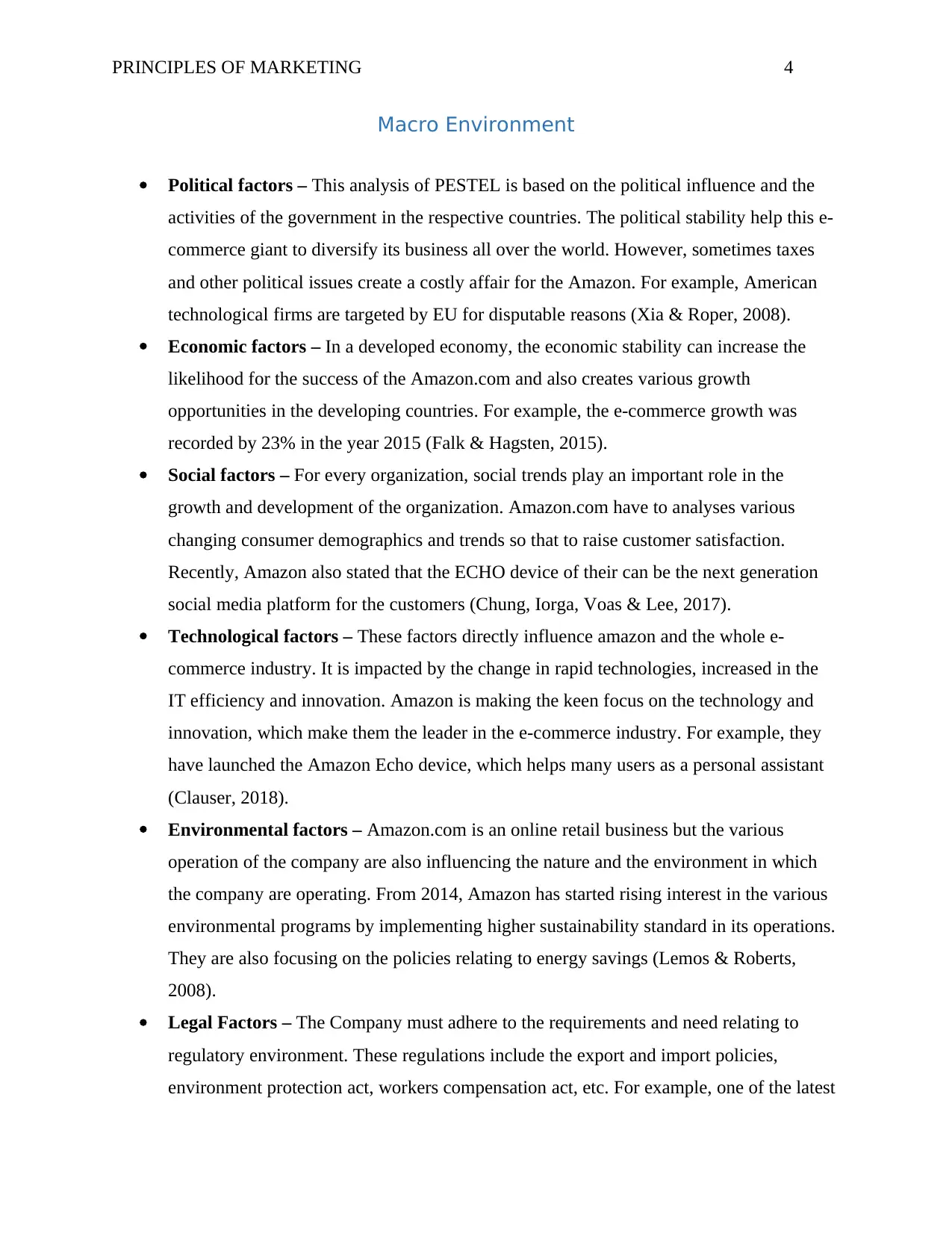
PRINCIPLES OF MARKETING 4
Macro Environment
Political factors – This analysis of PESTEL is based on the political influence and the
activities of the government in the respective countries. The political stability help this e-
commerce giant to diversify its business all over the world. However, sometimes taxes
and other political issues create a costly affair for the Amazon. For example, American
technological firms are targeted by EU for disputable reasons (Xia & Roper, 2008).
Economic factors – In a developed economy, the economic stability can increase the
likelihood for the success of the Amazon.com and also creates various growth
opportunities in the developing countries. For example, the e-commerce growth was
recorded by 23% in the year 2015 (Falk & Hagsten, 2015).
Social factors – For every organization, social trends play an important role in the
growth and development of the organization. Amazon.com have to analyses various
changing consumer demographics and trends so that to raise customer satisfaction.
Recently, Amazon also stated that the ECHO device of their can be the next generation
social media platform for the customers (Chung, Iorga, Voas & Lee, 2017).
Technological factors – These factors directly influence amazon and the whole e-
commerce industry. It is impacted by the change in rapid technologies, increased in the
IT efficiency and innovation. Amazon is making the keen focus on the technology and
innovation, which make them the leader in the e-commerce industry. For example, they
have launched the Amazon Echo device, which helps many users as a personal assistant
(Clauser, 2018).
Environmental factors – Amazon.com is an online retail business but the various
operation of the company are also influencing the nature and the environment in which
the company are operating. From 2014, Amazon has started rising interest in the various
environmental programs by implementing higher sustainability standard in its operations.
They are also focusing on the policies relating to energy savings (Lemos & Roberts,
2008).
Legal Factors – The Company must adhere to the requirements and need relating to
regulatory environment. These regulations include the export and import policies,
environment protection act, workers compensation act, etc. For example, one of the latest
Macro Environment
Political factors – This analysis of PESTEL is based on the political influence and the
activities of the government in the respective countries. The political stability help this e-
commerce giant to diversify its business all over the world. However, sometimes taxes
and other political issues create a costly affair for the Amazon. For example, American
technological firms are targeted by EU for disputable reasons (Xia & Roper, 2008).
Economic factors – In a developed economy, the economic stability can increase the
likelihood for the success of the Amazon.com and also creates various growth
opportunities in the developing countries. For example, the e-commerce growth was
recorded by 23% in the year 2015 (Falk & Hagsten, 2015).
Social factors – For every organization, social trends play an important role in the
growth and development of the organization. Amazon.com have to analyses various
changing consumer demographics and trends so that to raise customer satisfaction.
Recently, Amazon also stated that the ECHO device of their can be the next generation
social media platform for the customers (Chung, Iorga, Voas & Lee, 2017).
Technological factors – These factors directly influence amazon and the whole e-
commerce industry. It is impacted by the change in rapid technologies, increased in the
IT efficiency and innovation. Amazon is making the keen focus on the technology and
innovation, which make them the leader in the e-commerce industry. For example, they
have launched the Amazon Echo device, which helps many users as a personal assistant
(Clauser, 2018).
Environmental factors – Amazon.com is an online retail business but the various
operation of the company are also influencing the nature and the environment in which
the company are operating. From 2014, Amazon has started rising interest in the various
environmental programs by implementing higher sustainability standard in its operations.
They are also focusing on the policies relating to energy savings (Lemos & Roberts,
2008).
Legal Factors – The Company must adhere to the requirements and need relating to
regulatory environment. These regulations include the export and import policies,
environment protection act, workers compensation act, etc. For example, one of the latest

PRINCIPLES OF MARKETING 5
legal factors affects the business of Amazon is the probing of taxes and patents suits by
SEC (Jeruss, Feldman & Walker, 2012).
Micro Environment
This environment includes various factors relating to the business of Amazon like
suppliers, customers, competitors and employees. These factors have a direct impact on the
operations of the firms. Suppliers control the availability of the resources and product sell on
Amazon.com. For example, the suppliers in small population but with stronger force will affect
Amazon operations cost when there is any change in the price of the equipment.
Amazon also needs to use a customer centric approach for doing the business. As due to
many rivalries in the market, they have strong power in the switching cost and substitutes.
Considering the employees, Amazon also uses intensive management approach, which
focuses on the leadership development, harmony and promotes balances in the work-life (B,
2018). According to the Amazon, a customer can only able to sever customer efficiently if the
necessary potential being raised inside him/her.
Competitors Analysis
When it comes to e-commerce, one of the major competitors of Amazon is Alibaba, the
Chinese e-commerce giant. Alibaba follows a different business model as unlike Amazon, the
inventory ownership is not taken by them as they stock it in their distribution center and then
full-fill the order.
Because of the dissimilar business models, Amazon and Alibaba have different
approaches towards the Omni-channel logistics. Amazon competes against the Omni-channel
initiatives of retailers.
The analysis can be made in terms of revenue, customer accounts, market share, services
and products, market capitalization, major shareholders, traffics, metrics of brand trusting,
legal factors affects the business of Amazon is the probing of taxes and patents suits by
SEC (Jeruss, Feldman & Walker, 2012).
Micro Environment
This environment includes various factors relating to the business of Amazon like
suppliers, customers, competitors and employees. These factors have a direct impact on the
operations of the firms. Suppliers control the availability of the resources and product sell on
Amazon.com. For example, the suppliers in small population but with stronger force will affect
Amazon operations cost when there is any change in the price of the equipment.
Amazon also needs to use a customer centric approach for doing the business. As due to
many rivalries in the market, they have strong power in the switching cost and substitutes.
Considering the employees, Amazon also uses intensive management approach, which
focuses on the leadership development, harmony and promotes balances in the work-life (B,
2018). According to the Amazon, a customer can only able to sever customer efficiently if the
necessary potential being raised inside him/her.
Competitors Analysis
When it comes to e-commerce, one of the major competitors of Amazon is Alibaba, the
Chinese e-commerce giant. Alibaba follows a different business model as unlike Amazon, the
inventory ownership is not taken by them as they stock it in their distribution center and then
full-fill the order.
Because of the dissimilar business models, Amazon and Alibaba have different
approaches towards the Omni-channel logistics. Amazon competes against the Omni-channel
initiatives of retailers.
The analysis can be made in terms of revenue, customer accounts, market share, services
and products, market capitalization, major shareholders, traffics, metrics of brand trusting,
⊘ This is a preview!⊘
Do you want full access?
Subscribe today to unlock all pages.

Trusted by 1+ million students worldwide
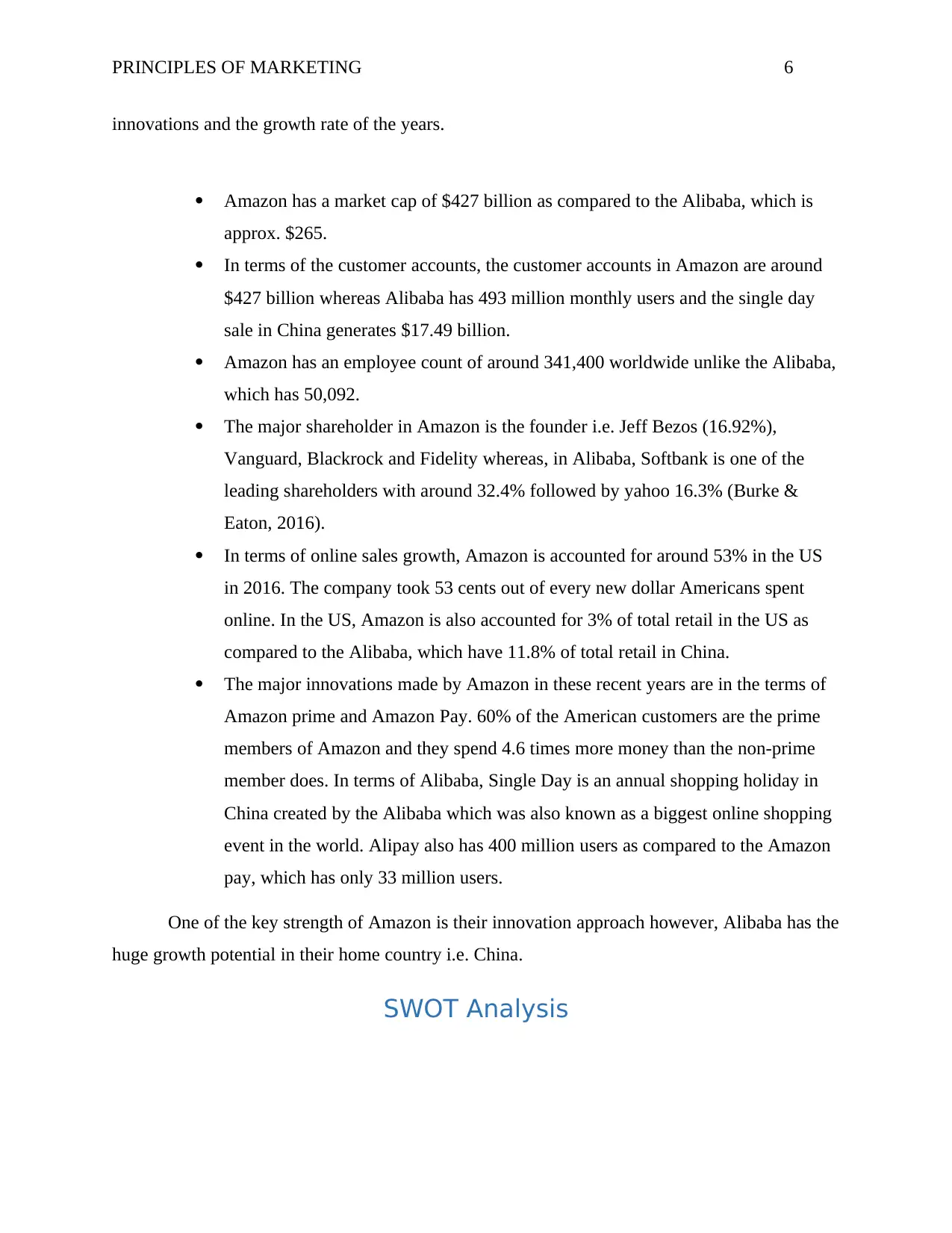
PRINCIPLES OF MARKETING 6
innovations and the growth rate of the years.
Amazon has a market cap of $427 billion as compared to the Alibaba, which is
approx. $265.
In terms of the customer accounts, the customer accounts in Amazon are around
$427 billion whereas Alibaba has 493 million monthly users and the single day
sale in China generates $17.49 billion.
Amazon has an employee count of around 341,400 worldwide unlike the Alibaba,
which has 50,092.
The major shareholder in Amazon is the founder i.e. Jeff Bezos (16.92%),
Vanguard, Blackrock and Fidelity whereas, in Alibaba, Softbank is one of the
leading shareholders with around 32.4% followed by yahoo 16.3% (Burke &
Eaton, 2016).
In terms of online sales growth, Amazon is accounted for around 53% in the US
in 2016. The company took 53 cents out of every new dollar Americans spent
online. In the US, Amazon is also accounted for 3% of total retail in the US as
compared to the Alibaba, which have 11.8% of total retail in China.
The major innovations made by Amazon in these recent years are in the terms of
Amazon prime and Amazon Pay. 60% of the American customers are the prime
members of Amazon and they spend 4.6 times more money than the non-prime
member does. In terms of Alibaba, Single Day is an annual shopping holiday in
China created by the Alibaba which was also known as a biggest online shopping
event in the world. Alipay also has 400 million users as compared to the Amazon
pay, which has only 33 million users.
One of the key strength of Amazon is their innovation approach however, Alibaba has the
huge growth potential in their home country i.e. China.
SWOT Analysis
innovations and the growth rate of the years.
Amazon has a market cap of $427 billion as compared to the Alibaba, which is
approx. $265.
In terms of the customer accounts, the customer accounts in Amazon are around
$427 billion whereas Alibaba has 493 million monthly users and the single day
sale in China generates $17.49 billion.
Amazon has an employee count of around 341,400 worldwide unlike the Alibaba,
which has 50,092.
The major shareholder in Amazon is the founder i.e. Jeff Bezos (16.92%),
Vanguard, Blackrock and Fidelity whereas, in Alibaba, Softbank is one of the
leading shareholders with around 32.4% followed by yahoo 16.3% (Burke &
Eaton, 2016).
In terms of online sales growth, Amazon is accounted for around 53% in the US
in 2016. The company took 53 cents out of every new dollar Americans spent
online. In the US, Amazon is also accounted for 3% of total retail in the US as
compared to the Alibaba, which have 11.8% of total retail in China.
The major innovations made by Amazon in these recent years are in the terms of
Amazon prime and Amazon Pay. 60% of the American customers are the prime
members of Amazon and they spend 4.6 times more money than the non-prime
member does. In terms of Alibaba, Single Day is an annual shopping holiday in
China created by the Alibaba which was also known as a biggest online shopping
event in the world. Alipay also has 400 million users as compared to the Amazon
pay, which has only 33 million users.
One of the key strength of Amazon is their innovation approach however, Alibaba has the
huge growth potential in their home country i.e. China.
SWOT Analysis
Paraphrase This Document
Need a fresh take? Get an instant paraphrase of this document with our AI Paraphraser
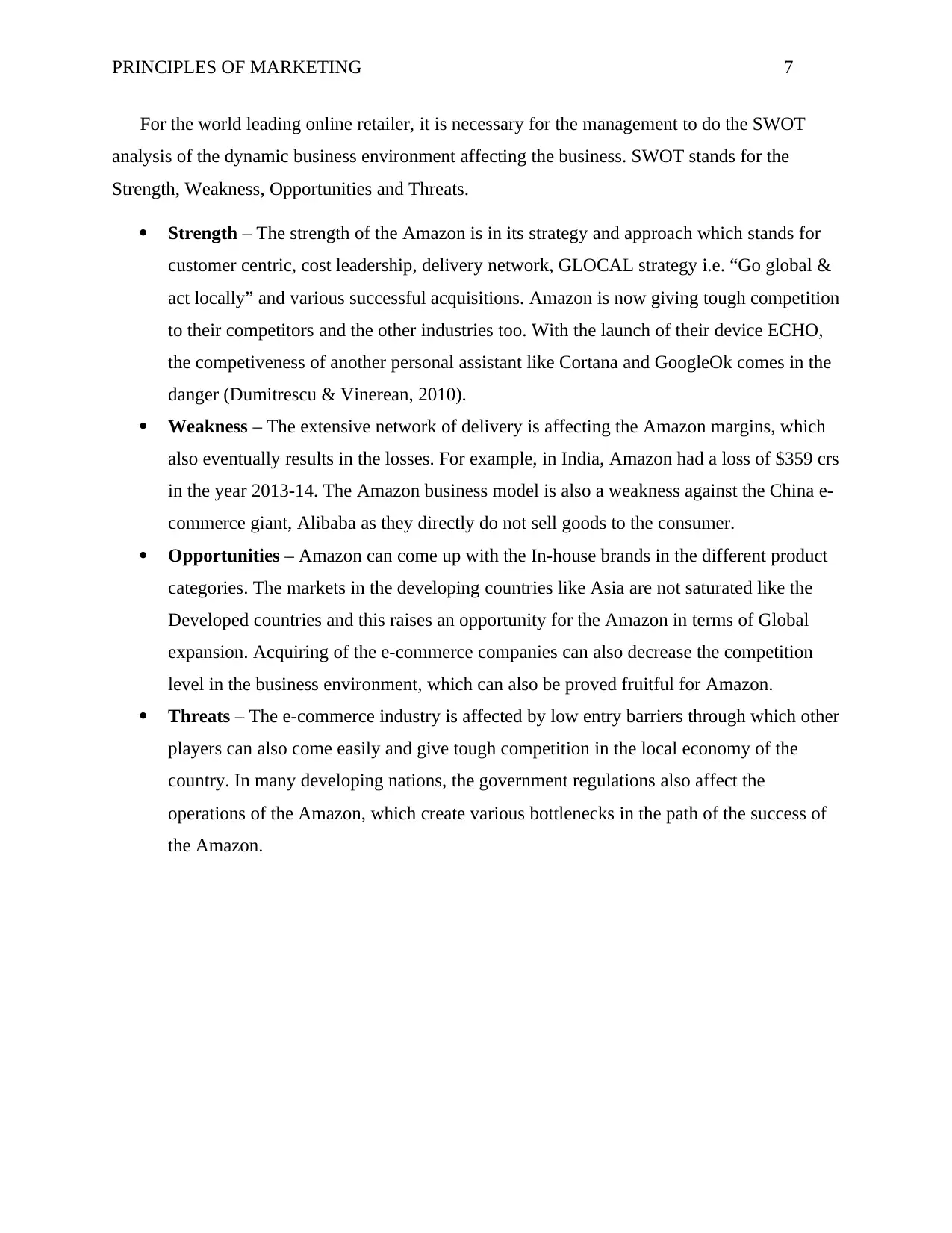
PRINCIPLES OF MARKETING 7
For the world leading online retailer, it is necessary for the management to do the SWOT
analysis of the dynamic business environment affecting the business. SWOT stands for the
Strength, Weakness, Opportunities and Threats.
Strength – The strength of the Amazon is in its strategy and approach which stands for
customer centric, cost leadership, delivery network, GLOCAL strategy i.e. “Go global &
act locally” and various successful acquisitions. Amazon is now giving tough competition
to their competitors and the other industries too. With the launch of their device ECHO,
the competiveness of another personal assistant like Cortana and GoogleOk comes in the
danger (Dumitrescu & Vinerean, 2010).
Weakness – The extensive network of delivery is affecting the Amazon margins, which
also eventually results in the losses. For example, in India, Amazon had a loss of $359 crs
in the year 2013-14. The Amazon business model is also a weakness against the China e-
commerce giant, Alibaba as they directly do not sell goods to the consumer.
Opportunities – Amazon can come up with the In-house brands in the different product
categories. The markets in the developing countries like Asia are not saturated like the
Developed countries and this raises an opportunity for the Amazon in terms of Global
expansion. Acquiring of the e-commerce companies can also decrease the competition
level in the business environment, which can also be proved fruitful for Amazon.
Threats – The e-commerce industry is affected by low entry barriers through which other
players can also come easily and give tough competition in the local economy of the
country. In many developing nations, the government regulations also affect the
operations of the Amazon, which create various bottlenecks in the path of the success of
the Amazon.
For the world leading online retailer, it is necessary for the management to do the SWOT
analysis of the dynamic business environment affecting the business. SWOT stands for the
Strength, Weakness, Opportunities and Threats.
Strength – The strength of the Amazon is in its strategy and approach which stands for
customer centric, cost leadership, delivery network, GLOCAL strategy i.e. “Go global &
act locally” and various successful acquisitions. Amazon is now giving tough competition
to their competitors and the other industries too. With the launch of their device ECHO,
the competiveness of another personal assistant like Cortana and GoogleOk comes in the
danger (Dumitrescu & Vinerean, 2010).
Weakness – The extensive network of delivery is affecting the Amazon margins, which
also eventually results in the losses. For example, in India, Amazon had a loss of $359 crs
in the year 2013-14. The Amazon business model is also a weakness against the China e-
commerce giant, Alibaba as they directly do not sell goods to the consumer.
Opportunities – Amazon can come up with the In-house brands in the different product
categories. The markets in the developing countries like Asia are not saturated like the
Developed countries and this raises an opportunity for the Amazon in terms of Global
expansion. Acquiring of the e-commerce companies can also decrease the competition
level in the business environment, which can also be proved fruitful for Amazon.
Threats – The e-commerce industry is affected by low entry barriers through which other
players can also come easily and give tough competition in the local economy of the
country. In many developing nations, the government regulations also affect the
operations of the Amazon, which create various bottlenecks in the path of the success of
the Amazon.
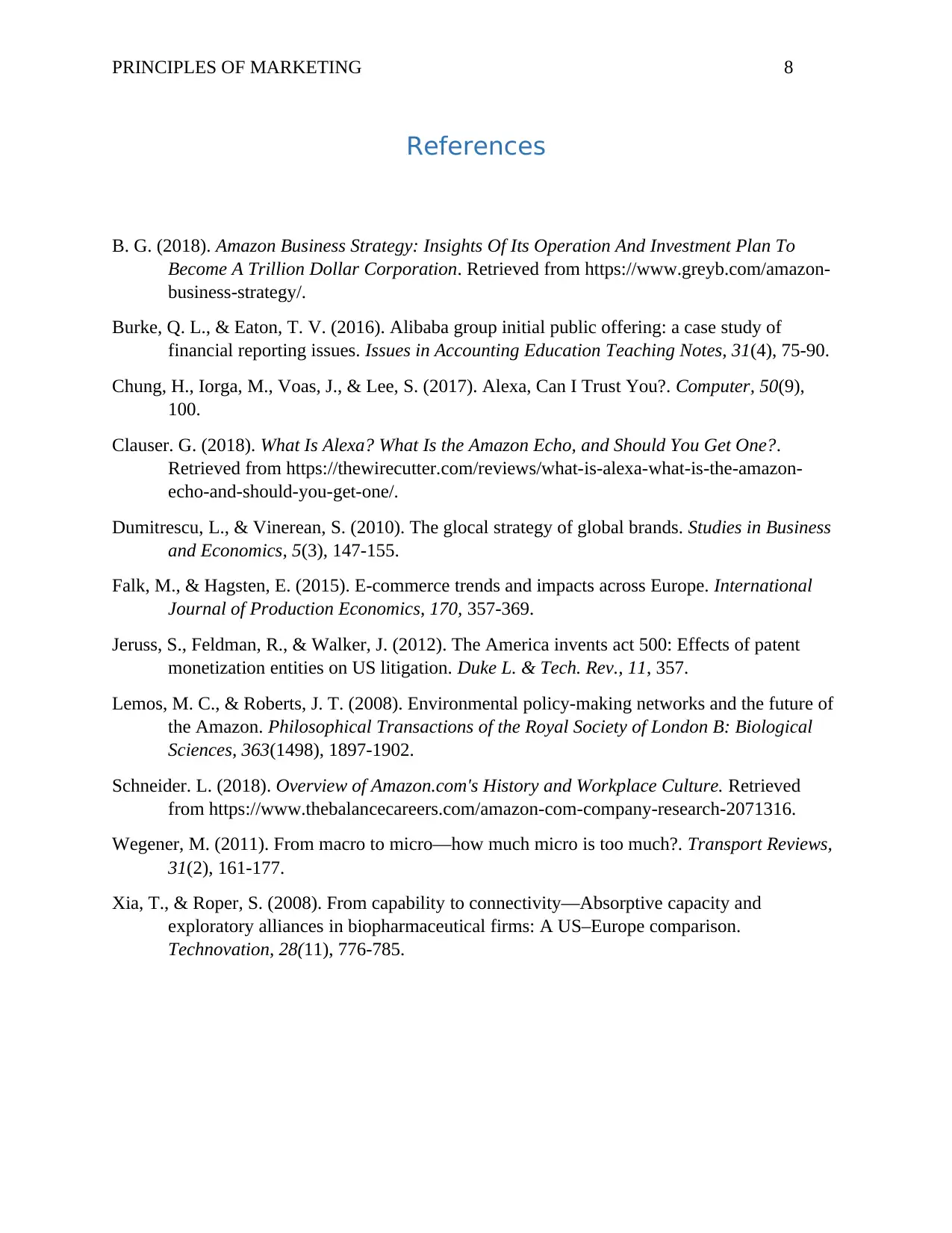
PRINCIPLES OF MARKETING 8
References
B. G. (2018). Amazon Business Strategy: Insights Of Its Operation And Investment Plan To
Become A Trillion Dollar Corporation. Retrieved from https://www.greyb.com/amazon-
business-strategy/.
Burke, Q. L., & Eaton, T. V. (2016). Alibaba group initial public offering: a case study of
financial reporting issues. Issues in Accounting Education Teaching Notes, 31(4), 75-90.
Chung, H., Iorga, M., Voas, J., & Lee, S. (2017). Alexa, Can I Trust You?. Computer, 50(9),
100.
Clauser. G. (2018). What Is Alexa? What Is the Amazon Echo, and Should You Get One?.
Retrieved from https://thewirecutter.com/reviews/what-is-alexa-what-is-the-amazon-
echo-and-should-you-get-one/.
Dumitrescu, L., & Vinerean, S. (2010). The glocal strategy of global brands. Studies in Business
and Economics, 5(3), 147-155.
Falk, M., & Hagsten, E. (2015). E-commerce trends and impacts across Europe. International
Journal of Production Economics, 170, 357-369.
Jeruss, S., Feldman, R., & Walker, J. (2012). The America invents act 500: Effects of patent
monetization entities on US litigation. Duke L. & Tech. Rev., 11, 357.
Lemos, M. C., & Roberts, J. T. (2008). Environmental policy-making networks and the future of
the Amazon. Philosophical Transactions of the Royal Society of London B: Biological
Sciences, 363(1498), 1897-1902.
Schneider. L. (2018). Overview of Amazon.com's History and Workplace Culture. Retrieved
from https://www.thebalancecareers.com/amazon-com-company-research-2071316.
Wegener, M. (2011). From macro to micro—how much micro is too much?. Transport Reviews,
31(2), 161-177.
Xia, T., & Roper, S. (2008). From capability to connectivity—Absorptive capacity and
exploratory alliances in biopharmaceutical firms: A US–Europe comparison.
Technovation, 28(11), 776-785.
References
B. G. (2018). Amazon Business Strategy: Insights Of Its Operation And Investment Plan To
Become A Trillion Dollar Corporation. Retrieved from https://www.greyb.com/amazon-
business-strategy/.
Burke, Q. L., & Eaton, T. V. (2016). Alibaba group initial public offering: a case study of
financial reporting issues. Issues in Accounting Education Teaching Notes, 31(4), 75-90.
Chung, H., Iorga, M., Voas, J., & Lee, S. (2017). Alexa, Can I Trust You?. Computer, 50(9),
100.
Clauser. G. (2018). What Is Alexa? What Is the Amazon Echo, and Should You Get One?.
Retrieved from https://thewirecutter.com/reviews/what-is-alexa-what-is-the-amazon-
echo-and-should-you-get-one/.
Dumitrescu, L., & Vinerean, S. (2010). The glocal strategy of global brands. Studies in Business
and Economics, 5(3), 147-155.
Falk, M., & Hagsten, E. (2015). E-commerce trends and impacts across Europe. International
Journal of Production Economics, 170, 357-369.
Jeruss, S., Feldman, R., & Walker, J. (2012). The America invents act 500: Effects of patent
monetization entities on US litigation. Duke L. & Tech. Rev., 11, 357.
Lemos, M. C., & Roberts, J. T. (2008). Environmental policy-making networks and the future of
the Amazon. Philosophical Transactions of the Royal Society of London B: Biological
Sciences, 363(1498), 1897-1902.
Schneider. L. (2018). Overview of Amazon.com's History and Workplace Culture. Retrieved
from https://www.thebalancecareers.com/amazon-com-company-research-2071316.
Wegener, M. (2011). From macro to micro—how much micro is too much?. Transport Reviews,
31(2), 161-177.
Xia, T., & Roper, S. (2008). From capability to connectivity—Absorptive capacity and
exploratory alliances in biopharmaceutical firms: A US–Europe comparison.
Technovation, 28(11), 776-785.
⊘ This is a preview!⊘
Do you want full access?
Subscribe today to unlock all pages.

Trusted by 1+ million students worldwide
1 out of 9
Related Documents
Your All-in-One AI-Powered Toolkit for Academic Success.
+13062052269
info@desklib.com
Available 24*7 on WhatsApp / Email
![[object Object]](/_next/static/media/star-bottom.7253800d.svg)
Unlock your academic potential
Copyright © 2020–2025 A2Z Services. All Rights Reserved. Developed and managed by ZUCOL.





